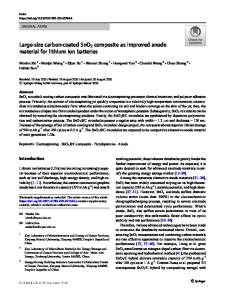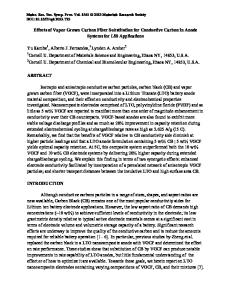Strongly binding natural stibnite on carbon fiber as anode for lithium-ion batteries
- PDF / 1,839,669 Bytes
- 8 Pages / 595.276 x 790.866 pts Page_size
- 90 Downloads / 358 Views
ORIGINAL PAPER
Strongly binding natural stibnite on carbon fiber as anode for lithium-ion batteries Juan Yu 1 & Bicheng Meng 1 & Yao Fu 2 & Wenlong Huang 1 & Lejie Wang 1 & Qi Wang 3 & Linbo Li 1 Received: 17 July 2020 / Revised: 11 August 2020 / Accepted: 11 August 2020 # Springer-Verlag GmbH Germany, part of Springer Nature 2020
Abstract The antimony sulfide (Sb2S3) as a new alternative anode for lithium-ion batteries has been widely studied because of its high theoretical specific capacity (946 mAh/g), good safety, and abundant resources. In this paper, a one-dimensional anode material with Sb2S3 nano-layers (Sb2S3-NLs) composite was prepared by a simple, efficient, and non-polluting mixed-melting method that uses carbon fiber material as a matrix and high-enrichment natural stibnite as a raw material. By controlling the holding time, the Sb2S3 ore that coated on the surface of carbon fiber (CF) is reorganized from unevenly distributed microparticles into nanosheets and nanoparticles. The CF@Sb2S3-NLs anode has a nanocomposite structure that can relieve the volume change of Sb2S3 and increase the contact area between the electrode materials, as well as shorten the ion/electron migration path and obtain excellent rate performance in the cycle process. Keywords Carbon fiber . Natural stibnite . Lithium-ion batteries . Anode
Introduction Social development and technological progress are inseparable from the support of energy whose exploitation and utilization are particularly important. In recent years, the continuous consumption of traditional fossil energy has caused many problems such as the shortage of energy supply, environmental pollution, and the greenhouse effect, which turns people’s attention to the development of the renewable energy [1–3]. Lithium-ion batteries (LIBs) with characteristics of the highest energy/power density, the best electrical energy conversion efficiency, and the longest cycle life are favored as commercial energy storage devices [4, 5]. With the continuous improvement of living standards, the higher requirements are brought forward on the next generation of LIBs, requiring them to be used not only in mobile and portable devices but
* Juan Yu [email protected] 1
School of Metallurgical Engineering, Xi’an University of Architecture and Technology, Xi’an 710055, China
2
Technology Center, Dalian Customs District, Dalian 116001, China
3
School of Metallurgy and Environment, Central South University, Changsha 410083, China
also in the fields of automobiles, aerospace, and military. To meet these requirements for LIBs, the new anode materials with higher energy density and other indicators need to be developed [6, 7], since the actual capacity of traditional commercial graphite (372 mAh/g) anode has been close to its theoretical limit [8, 9]. The Sb2S3 has been widely studied as a new alternative anode for LIBs because of its high theoretical specific capacity (946 mAh/g) [10], good safety, and abundant resources. However, the Sb2S3 as an anode material has the problems of lith
Data Loading...










